Labor Days
Reinventing the workweek in the Soviet Union
Tony Wood
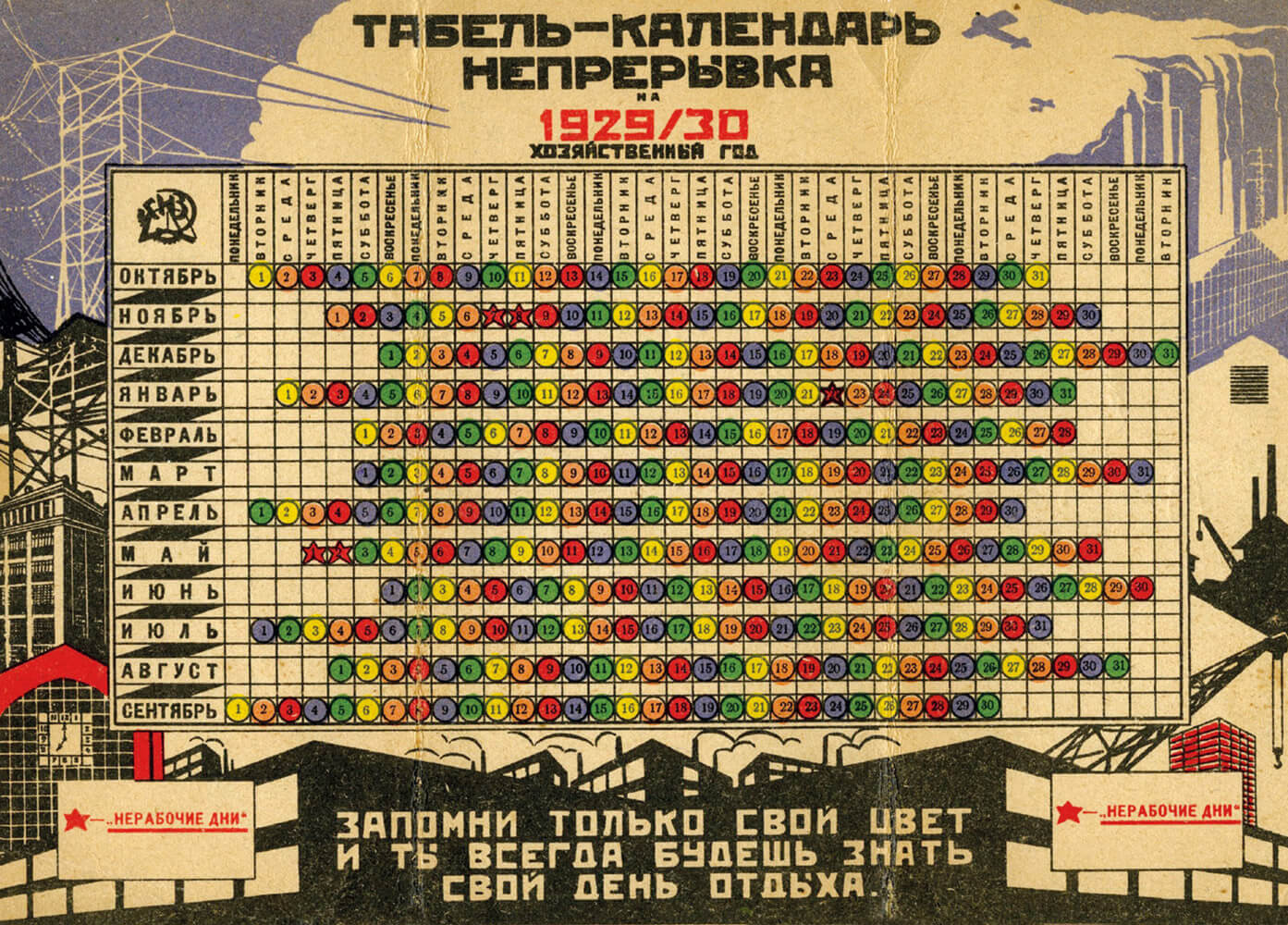
Among the many things to disappear during the world-shaking turmoil of the Russian Revolution—along with czarism, the aristocracy, private banks, landownership—were the first thirteen days of February. On 24 January 1918, Lenin signed a decree ordering the country to switch from the Julian calendar, used by the Orthodox Church, to the Gregorian, bringing revolutionary Russia into line with the rest of Europe. The two systems had been drifting more and more out of alignment since the sixteenth century, so much so that by 1918, making the change meant skipping directly from 31 January to 14 February. From then on, anyone referring to events that took place before this interregnum had to be clear whether the date they were using was Old Style or New Style. The shift also explains why the anniversary of the Great October Revolution was always celebrated in November, which often puzzled visitors to the USSR.
The 1918 calendar reform was an abrupt, one-off change, designed to signal the irreversibility of the leap from the ancien régime to the new. Undoing the revolution would now mean literally turning back time—which is what some upper-crust characters attempt to do in Sigizmund Krzhizhanovsky’s 1929 novella Memories of the Future when they ask the inventor of a time machine to take them back to the days of serfdom. Pushing the calendar forward was only one part, however, of a much broader campaign to sweep away backwardness and superstition and, in particular, to loosen the grip of religion on everyday life. Early on, the Soviets invented a series of ceremonies designed to replace Orthodox rituals: in addition to secular weddings and funerals, the government introduced “Octobering,” a Leninist alternative to baptism. There was also a weekly paper called Bezbozhnik—“Atheist,” “Godless One”—and, from 1925, a League of the Militant Godless. Yet, as the Bolsheviks found over the course of the next decade, much of the country was still deeply attached to religion, and still attuned to rhythms set by Church feasts, saints’ days, and the like. Even the names for the days of the week harbored a stubborn godliness: the Russian for Saturday is Subbota, from “Sabbath,” while the word for Sunday is simply “Resurrection,” Voskresen’e.
In August 1929, the Soviet government decreed a second calendar reform, which ostensibly had aims different from those of the 1918 switch. By the end of the 1920s, the country was in the midst of a frantic push to industrialize, spurred by the adoption of the first Five-Year Plan in 1928. A fever of construction seized hold of the nation, as bridges, factories, and even entire cities began to sprout across the landscape. The plan set a welter of ambitious targets that nations with more solid industrial bases would have struggled to meet; Soviet newspapers, posters, and films exhorted workers to ever-greater feats of industrial prowess by printing reams of statistics and glowing reports of “socialist competition” between factories seeking to outdo each other in “over-fulfilling” the plan. Valentin Kataev’s 1932 novel Time, Forward! describes one such struggle, focusing on a single day in which a factory tries to break the record for poured concrete. Surprisingly, the story manages to create quite a bit of suspense, its sentences racing forward in line with the quickening tempo of society as a whole. (The book even begins by getting out ahead of itself, opening with the words: “The first chapter is omitted for the time being.”)
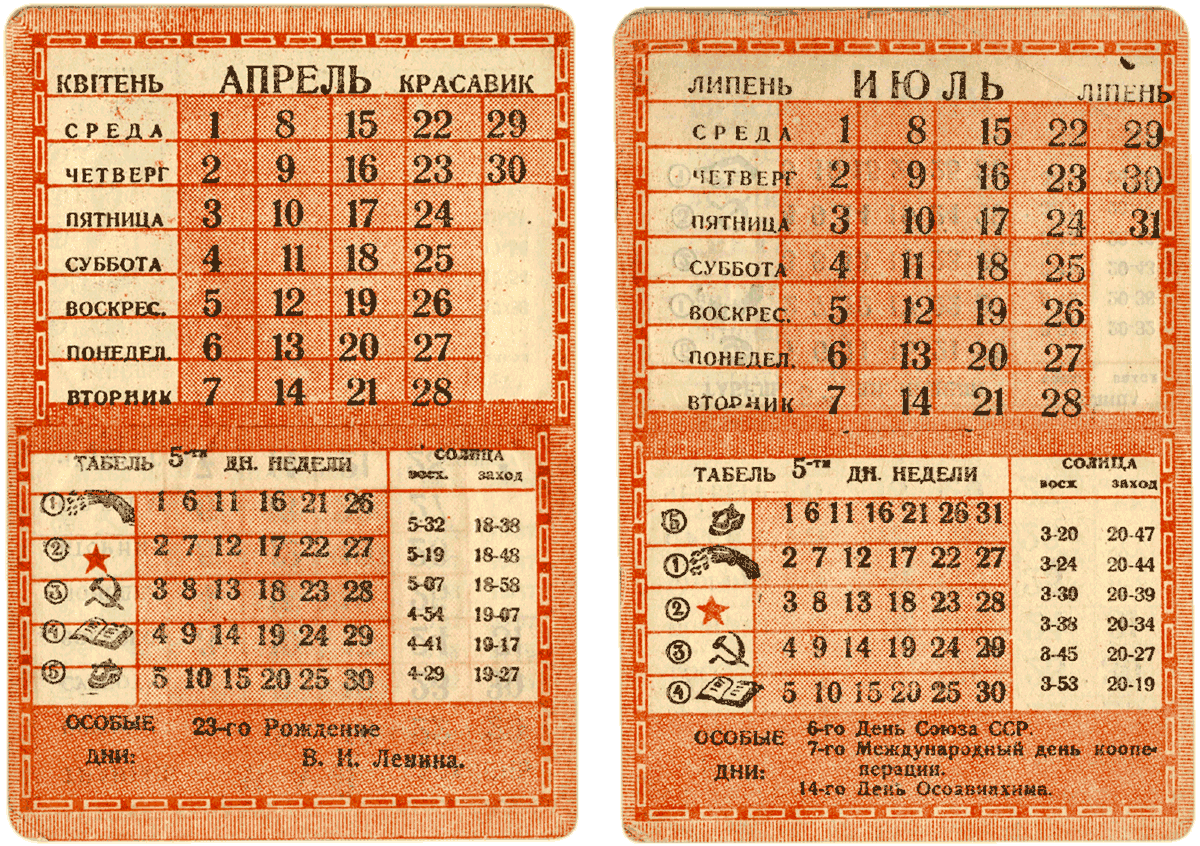
Right: The month of July from the same 1931 worker’s pocket calendar. Here, the five different work groups are represented by five symbols—a sheaf of wheat, a red star, the hammer and sickle, a book, and a budenovka, or wool military cap. Courtesy Erast Butakov.
This was the context in which Yuri Larin, a Bolshevik economist, began agitating for a plan that would allow factories to operate every day of the year. At the Fifth Congress of Soviets in May 1929, he advocated for what became known as the nepreryvka, the “continuous working week.”[1] This entailed dividing the workforce into groups and allocating each different rest days. In effect, the plan proposed to transfer the concept of a shift system to the days of the week. At first, Larin’s colleagues were unenthusiastic—especially the Commissariat of Labor, which was dubious about the logistics of running so many factories continuously. (It was hard enough getting supplies and workers for them to run at all: bottlenecks were a constant curse of the Soviet economy, and rates of absenteeism were especially high in the early stages of the industrialization drive.)[2] But Larin apparently managed to get Stalin’s ear, and by June, a proposal that weeks before had barely been discussed was being hailed in the press as “the great socialist idea.”
Larin’s plan involved more than a shift to a continuous workweek, however; it also meant switching the workforce from a seven-day to a five-day pattern. Until 1929, Soviet citizens worked for six days and rested on Sundays; from now on everyone would work for four days with one day off. Everyone would be getting more time off, but Larin clearly convinced the planners that the gains made from running factories continuously would more than compensate for the lost working hours. The workforce would be divided into five groups, each with a different rest day. The five shifts were often numbered. In many cases, they were color coded—red for 1, green for 2, and so on—and sometimes even symbols, such as hammer, sickle, red flag, airplane, and party membership card, were used to represent the different groups. The particular color scheme or symbols used varied from one workplace to another. Though the Soviet economy was centrally planned, many of the details of day-to-day life in the USSR depended on the individual enterprise where one worked; the same was true of the nepreryvka calendars, which could look quite dissimilar even for people employed in the same sector. Although the underlying principle was the same, the profusion of schedules must have been pretty disorienting. The benefits for industry of Larin’s new arrangement were obvious enough, but the workers themselves were less enthused. Even though it actually meant that everyone’s day off came around more quickly, family members and friends could not be guaranteed to have the same rest days, and as early as October 1929, Pravda was publishing letters of complaint from disgruntled (or bored?) workers:
What is there for us to do at home if our wives are in the factory, our children at school, and nobody can visit us, so that there is nothing left but to go to a State tearoom? What sort of a life is it if we are to rest in shifts and not together as a whole proletariat? It is no holiday if you have to have it alone.[3]
Larin’s scheme did allow for some days when the entire workforce could take a break—five, to be precise (which is why one of the pamphlets he published to explain how the nepreryvka would expand the number of workdays was titled 360 instead of 300). The new holidays everyone would share were 22 January, commemorating both Lenin’s death and the anniversary of Bloody Sunday, when czarist troops gunned down participants in a peaceful workers’ march in 1905; 1 and 2 May, to mark International Workers’ Day; and 7 and 8 November, to celebrate the October Revolution. But these aside, there was to be little opportunity for collective rest—the new Soviet calendar was decidedly short on mass festivities, with nothing like the stream of civic ceremonies the French Revolutionary calendar had envisaged.
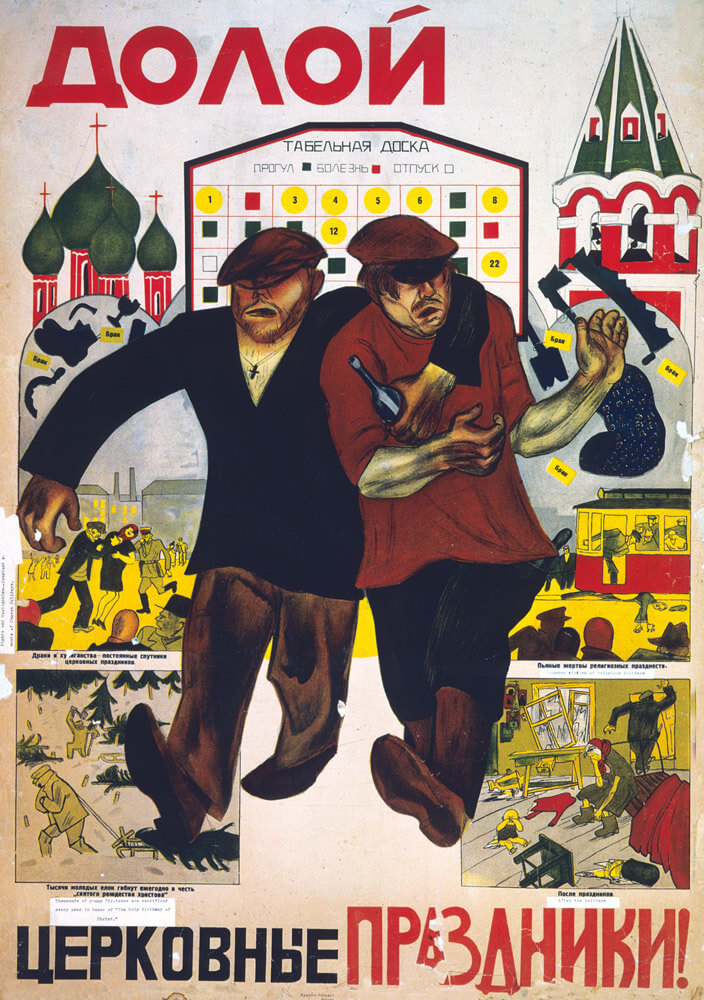
The continuous five-day week wasn’t just designed to reorganize industrial labor patterns and squeeze more hours out of the workforce. For most of the population, perhaps more significant was the nepreryvka’s implied assault not just on rest days per se, but on weekends specifically. The 1929 reform hadn’t totally done away with the seven days of the week: calendars laying out the five-day schema continued to refer to individual days by their traditional names, but now the workweek would begin on different days depending on one’s number or color. What had happened, then, was that the population’s working rhythm had been uncoupled from the standard seven-day cycle. Where the French revolutionaries had done away with the old days and months altogether, instituting an entirely new calendar instead, the Soviet nepreryvka was not so much a calendar reform as an attempt to subtract meaning from the existing calendar by overwriting it with another one. Since a worker’s rest day would keep falling on different days, surely no day could hold more significance than any other. Of course, there was one particular day this would affect more than others: in theory, the reform made it impossible for the population to properly observe religious holidays or to regularly attend church.
Eviatar Zerubavel, in his book on the history of the week, sees the nepreryvka’s anti-religious element as a key part of its appeal to the Soviet leadership, and its introduction as a continuation of the government’s earlier atheistic offensive: weekend rest days, “these two weekly bastions of Judeo-Christian religious sentiments, were clearly the main targets.”[4] It’s true that early on, the state propaganda announcing the benefits of the five-day week stressed its importance in combating piety; religious festivals also tended to encourage heavy drinking among workers. A propaganda poster from 1930 proudly announces, in rather clunky rhyming verse, that: “In the name of economic efficiency / Sundays have been burned off like rotten stumps: / There is no all-round festive idleness anymore! Everyone has his own days off!” The poster depicts a worker calculating how many days off he gets per year (the answer is seventy-two); perhaps it was this nationwide arithmetic test that entitled the poster to claim that the nepreryvka “raises the cultural level of the worker.”
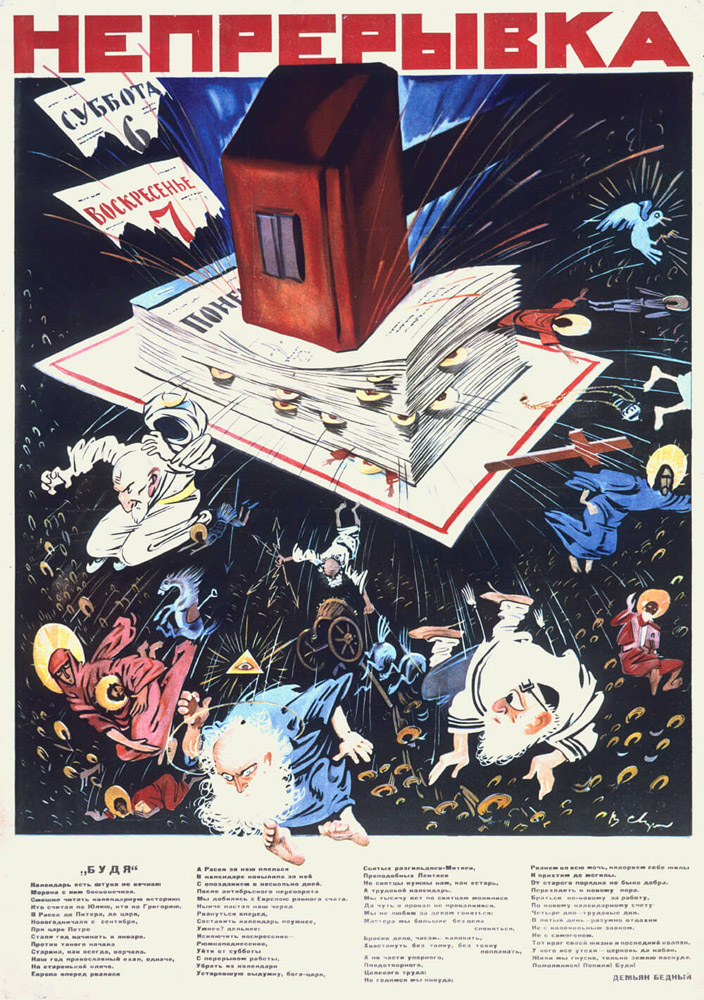
Although it was meant to be confined to industry and implemented gradually, the new five-day, continuous workweek spread rapidly. Within a year, the overwhelming majority of industrial enterprises reported that they had shifted to the new regimen, and large numbers of workplaces in other sectors had joined them, including many government offices, shops, cinemas, and restaurants.[5] The nepreryvka had brought a profound alteration to the rhythms of everyday life and leisure for the entire workforce. In that sense, Zerubavel’s argument that it was principally an anti-religious reform might be exaggerating its godless credentials: if anything, the five-day nepreryvka was not so much a destructive anti-Orthodox move as a gesture of secular faith in industrialization, an attempt to bring daily life in line with the demands of the machine age.
It wasn’t long, though, before the continuous five-day week ran into fairly predictable problems: breakdown of machinery through overuse, malcoordination of shifts, more frequent supply bottlenecks, grumbling from employees who never saw their families. In June 1931, Stalin made a speech in which he complained that “some of our comrades were a little hasty in introducing the uninterrupted working-week, and in their hurry distorted it and transformed it into a system of lack of personal responsibility.”[6] The system was then substantially changed by switching to a six-day pattern—five days on, one day off—and, crucially, giving everyone the same sixth day off. Rest days were now fixed on the sixth, twelfth, eighteenth, twenty-fourth, and thirtieth days of each month; Sundays were shorn of their regular place as the week’s endpoint. Indeed, the six-day week, or shestidnevka, was, like its five-day predecessor, designed to inhabit and gradually displace the seven-day week, like a cuckoo’s egg laid in another bird’s nest. Calendars from the late 1930s show months divided into six-day cycles, with the traditional names of the weekdays now replaced by ordinal numbers: first, second, third, etc. Months consisted of five six-day weeks, plus, in some cases, a thirty-first day that stood alone, and which was generally a “bonus” workday.
This revised version of the reform proved much more durable, lasting until 26 June 1940. Zerubavel argues that, over the course of the 1930s, the calendar reform in effect split the Soviet population into “two distinct societies,” an urban industrial segment operating on a six-day, secularized cycle and the residents of the rural hinterlands, who completely disregarded the new calendars devised in Moscow and continued to follow the seven-day “beat”—carrying on with their peasant markets and going to church on Sundays.[7] In this respect, the abolition of the shestidnevka could be seen as a victory for the old seven-day cycle and for the deep, rural past, which eventually reasserted itself despite the secularizing ambitions of the Soviet state.
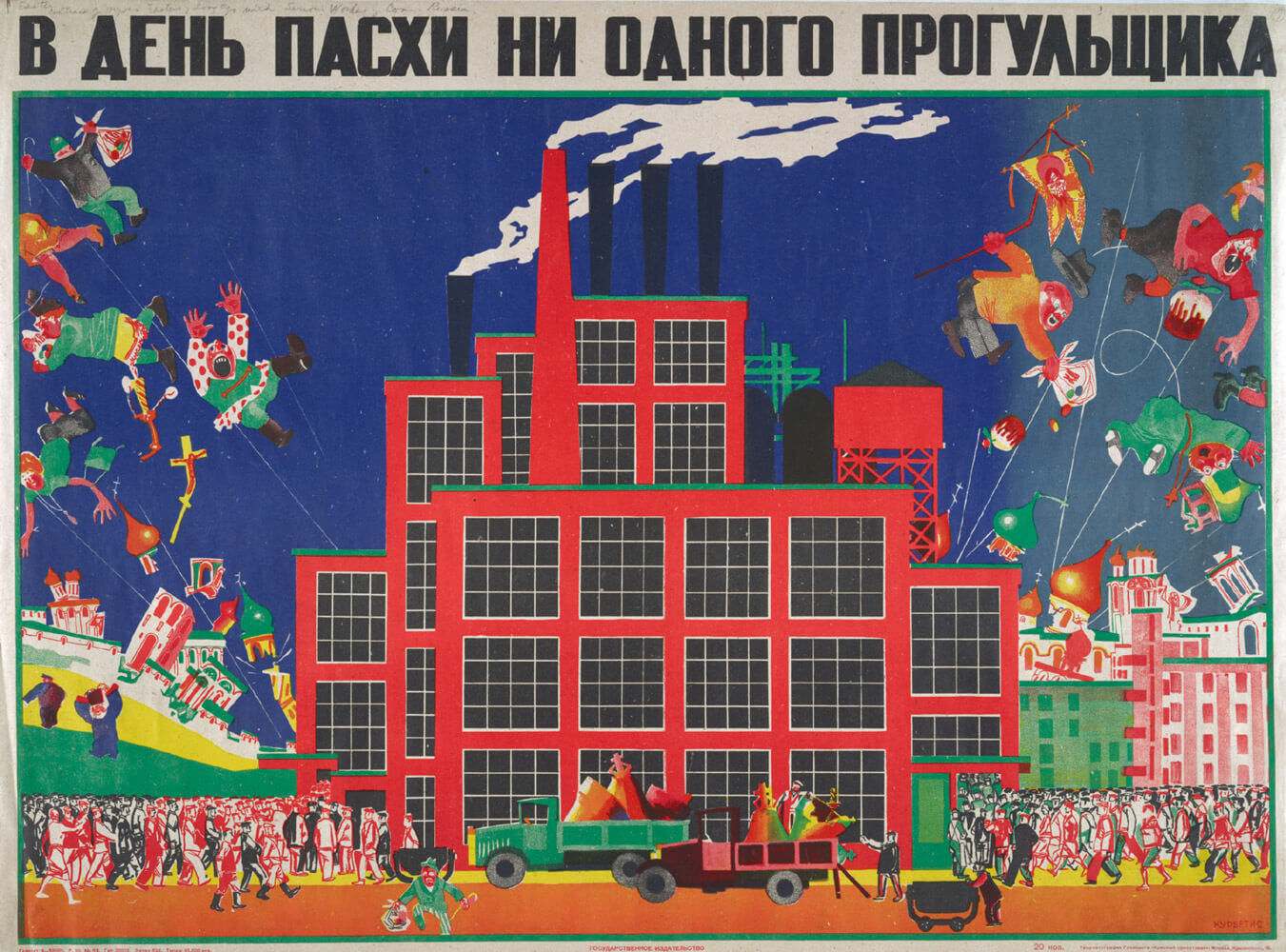
But this view may rest on too stark an opposition between the industrial, urban realm and a foot-dragging agrarian world. What took place during the 1930s was often a paradoxical fusion of the two. In that decade, the USSR experienced one of the most rapid and extensive processes of urbanization the world had ever seen; at the same time, the human flood from the countryside was so enormous that it ended up “ruralizing” the cities—hence the oxymoronic title of David Hoffmann’s portrait of Moscow in the 1930s, Peasant Metropolis.[8] Factory work, too, was partly ruralized. Soviet sources are rife with complaints about the failure of newly arrived migrants to shed their old work habits, in particular the tendency to slack for long periods of time only to compensate in a frantic rush as deadlines neared—a pattern of “storming” that remained a feature of the Soviet economy till the end. The whole character of the Soviet system, in other words, was shaped by the collision and conflation of rural and urban rhythms. Rather than seeing one as having ultimately defeated the other, you could call it a draw: while much of the population did continue to observe religious traditions on the sly, the country that returned to the seven-day pattern in 1940 had been transformed into an industrial superpower. When it was put to the test in World War II, the USSR ultimately outmatched the German industrial machine—and there the outcome was definitely not a draw. The most important public holiday in Russia is still Victory Day, commemorating the final German surrender of 1945. Here again, though, Russian and Western calendars differ: the other World War II Allies mark the occasion on 8 May, when the act of surrender was drawn up; the Russians, following the Soviets, choose instead to remember 9 May, when the documents were actually signed, in the small hours of a Wednesday morning in Berlin.
- For an early account of the origins and implementation of the nepreryvka, see [n.a.], “The Continuous Working Week in Soviet Russia,” International Labour Review, vol. 23, no. 2, February 1931; see also Eviatar Zerubavel, The Seven Day Circle: The History and Meaning of the Week (New York: The Free Press, 1985), pp. 35–43.
- R. W. Davies, The Industrialisation of Soviet Russia, vol. 3, The Soviet Economy in Turmoil, 1929–1930 (London: Macmillan, 1989), p. 85.
- Quoted in [n.a.], “The Continuous Working Week in Soviet Russia,” p. 176.
- Eviatar Zerubavel, The Seven Day Circle, p. 36.
- See [n.a], “The Continuous Working Week in Soviet Russia,” pp. 164–166.
- Joseph Stalin, “New Conditions—New Tasks in Economic Construction,” speech delivered on 23 June 1931. Published in Joseph Stalin, Works, vol. 13 (Moscow: Foreign Languages Publishing House, 1954). Available at marxists.org/reference/archive/stalin/works/1931/06/23.htm.
- Eviatar Zerubavel, The Seven Day Circle, p. 42.
- David L. Hoffmann, Peasant Metropolis: Social Identities in Moscow, 1929–1941 (Ithaca, NY: Cornell University Press, 1994).
Tony Wood studies history at New York University. A member of the editorial board of New Left Review, he is the author of Chechnya: The Case for Independence (Verso Books, 2007) and is completing a book on Putin’s Russia.
Spotted an error? Email us at corrections at cabinetmagazine dot org.
If you’ve enjoyed the free articles that we offer on our site, please consider subscribing to our nonprofit magazine. You get twelve online issues and unlimited access to all our archives.